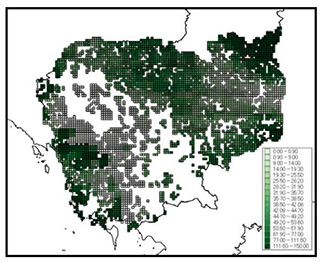Home > International Partnerships > Collaborative Research > Decomposition of Soil Organic Matter in Relation to Different Stages of Forest Degradation in the Tropics
Update:March 2, 2020
Main content starts here.
Decomposition of Soil Organic Matter in Relation to Different Stages of Forest Degradation in the Tropics

1. Partners
Institute of Forest and Wildlife Research and Development, Cambodia
Ministry of Environment, Cambodia
2. Research Period
FY 2014-2017 Grant-in-Aid for Scientific Research (KAKENHI)
3. Lead Researcher
TORIYAMA, Jumpei
4. Background
In tropical regions, soil organic matter (SOM) enhances the productivity of agricultural and forested lands and consequently forms the basis for sustaining human societies. Therefore, there is an urgent need for tropical countries to estimate the effects of rapid deforestation and forest degradation on the decomposition rate of SOM and to predict the storage and potential loss of SOM at a national scale. However, in many countries, the development of an appropriate methodology is less advanced due to a lack of data on the distribution of soil organic carbon (SOC), which is the skeleton of SOM.
5. Research Goal
The goals of this study were to develop a methodology for predicting the storage and potential loss of SOM in tropical countries that are experiencing deforestation and forest degradation and to create a dataset on the distribution of SOC in Cambodia.
6. Research Strategy
We conducted the following research with help from the Institute of Forest and Wildlife Research and Development and the Ministry of Environment, Cambodia:
1) A follow-up census of SOM in central Cambodia.
We conducted two soil surveys at the same location in each of 10 sites in central Cambodia during 2010 and 2014, respectively, to estimate the rate of SOM decomposition.
2) Estimation of SOC storage at a national scale in Cambodia.
We created an open dataset on SOC in Cambodia and used this to estimate SOC storage at a national scale.
7. Scientific Achievement
We obtained two key results from this research:
1) The rate of decrease in SOM at a depth of 0–30 cm was relatively low in the study area – for example, a rate of 1%–2% over 4 years was calculated for a forest-to-cassava (Manihot esculenta) conversion area, which is much lower than the values that have previously been reported for forest-to-rubber (Hevea brasiliensis) conversion areas in central Cambodia (e.g., 40% over 10 years). In addition to the difference in land-use types, this variation in rate of decrease in SOM may have been due to differences in soil texture (e.g., sandy soil in the cassava area and clayey soil in the rubber area).
2) The open dataset contained SOC data from 309 soil horizons across 66 Cambodian forest sites (Toriyama et al. 2018). We used this dataset in combination with a spatial dataset (e.g., vegetation and climate) to construct a multiple regression model to estimate SOC storage in Cambodian forests (Fig.). We also estimated the potential loss of SOC at a national scale based on the estimation model for the labile SOC pool (Toriyama et al. 2015). The results with respect to the storage of SOC can be interpreted in relation to SOM.

Fig. Storage of soil organic carbon in forested area in Cambodia
Soil depth is 0-30 cm. The unit is MgC ha-1
8. Applications
The Paris Agreement that was adopted in December 2015 contains a clause promoting activities relating to the reduction of emissions from deforestation and forest degradation and the fostering of conservation, the sustainable management of forests, and the enhancement of forest carbon stocks in developing countries (REDD+), and the achievements of this study support this clause. In addition, this study will contribute to the further improvement of the map of the global distribution of SOC (GSOCmap), which was first released by the Food and Agriculture Organization (FAO) in December 2017, particularly in tropical countries where fewer data are available for validation.
9. Publications
J. Toriyama, M. Hak, A. Imaya, K. Hirai, Y. Kiyono (2015) Effects of forest type and environmental factors on the soil organic carbon pool and its density fractions in a seasonally dry tropical forest. Forest Ecology and Management, 335: 147-155.
J. Toriyama, A. Imaya, K. Hirai (2018) Dataset of soil carbon stock in Cambodian forests. Bulletin of FFPRI 17-2(446): 175-186. (Research record)(Open access by FFPRI, http://www.ffpri.affrc.go.jp/pubs/bulletin/446/446toc-en.html)
Copyright © Forest Research and Management Organization. All rights reserved.
